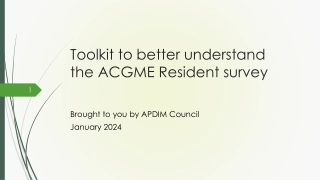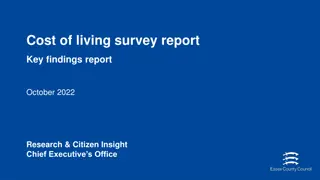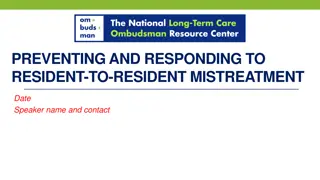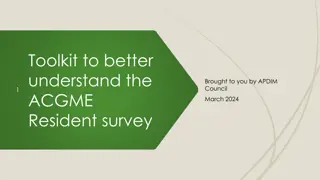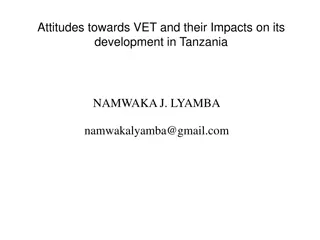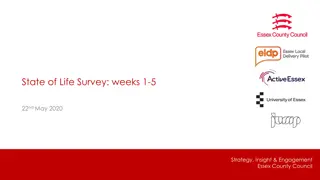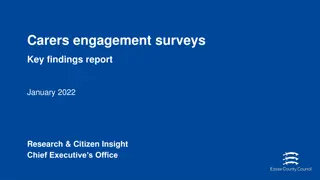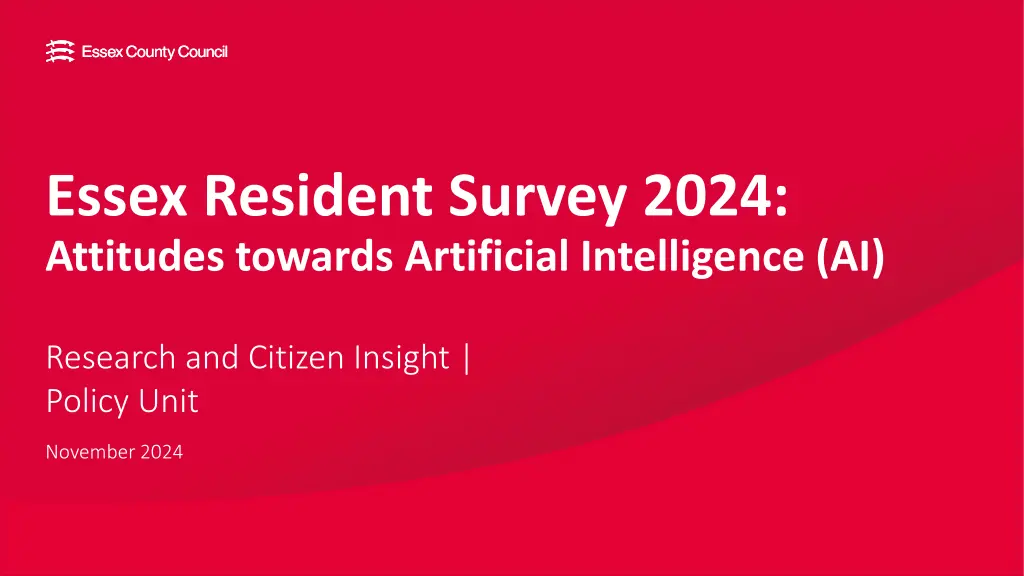
Essex Resident Survey 2024: Attitudes towards Artificial Intelligence Research
Explore key findings from the 2024 Essex Resident Survey focusing on attitudes towards Artificial Intelligence research and citizen insights. Gain valuable insights into residents' aspirations, views, and values that shape strategies and inform decision-making processes. The survey aims to enhance collaboration with residents and improve services for better community engagement.
Download Presentation

Please find below an Image/Link to download the presentation.
The content on the website is provided AS IS for your information and personal use only. It may not be sold, licensed, or shared on other websites without obtaining consent from the author. If you encounter any issues during the download, it is possible that the publisher has removed the file from their server.
You are allowed to download the files provided on this website for personal or commercial use, subject to the condition that they are used lawfully. All files are the property of their respective owners.
The content on the website is provided AS IS for your information and personal use only. It may not be sold, licensed, or shared on other websites without obtaining consent from the author.
E N D
Presentation Transcript
Essex Resident Survey 2024: Attitudes towards Artificial Intelligence (AI) Research and Citizen Insight | Policy Unit November 2024
Purpose Since 2006, Essex County Council (ECC) has conducted surveys of its residents to track outcomes and gather insight. The Essex Resident Survey is our biggest survey exercise and aims to generate insights: on residents aspirations, views and values helping to shape strategy, inform key ECC delivery programmes and our engagement with residents; generate insights to inform specific decisions on service transformation and resource prioritisation; and that help better understand the views of residents on key issues, informing the work that Essex County Council and its partners do to help improve life in Essex. These slides provide key findings from the 2024 Essex Resident Survey related to internet usage and attitudes towards data sharing.
About the survey The 2024 Resident Survey is a sample survey designed to: be representative of the Essex adult population; provide insight on specific groups and cohorts; and draw conclusions at the district level. The survey was delivered in partnership with Opinion Research Services (ORS) and conducted in line with Market Research Society standards. Fieldwork took place during March - May 2024. 37,301 households received an invite to participate in the survey, which could be completed online or via a paper questionnaire. A total of 5,613 residents aged 18+ responded to the 2024 survey. This provides a robust sample size which enables reliable analysis of the data by area and by population sub-groups.
Survey themes Physical activity Wellbeing Perceptions of ECC Climate change Local public services Sustainable growth Local area Food waste Attitudes towards AI About people and their household
Survey analysis The survey has been designed to ensure that all the themes and questions can be examined by: Gender Levelling up priority places Age Household composition Long-term limiting health condition/illness Families with children District Personal / household working status Level of neighbourhood deprivation Household income Urban/rural classification Tenure
Reporting conventions Percentages displayed on charts may not always add up to 100% due to rounding Statistically significant results are displayed throughout the report for key geographies and sub-groups. Unless otherwise specified, these are calculated against the Essex total at the 95% confidence level, with significantly higher results (versus the total) displayed using green boxes/upward arrows and significantly lower results displayed using red boxes/downward arrows. Sub-group differences are shown for levelling up priority places. It should be noted that these include just the core areas shown within the annex (i.e. not including rural Braintree). Levelling up priority places have been identified within the data based on the geographies used by ECC s Community Challenge Fund. Sub-group differences are also shown based on an area s ranking on the Index of Multiple Deprivation (IMD) 2019. These are shown within the report as quintiles 1-5, where: Quintile 1 includes areas ranked within the 20% most deprived nationally on the IMD Quintile 5 includes areas ranked within the 20% least deprived nationally on the IMD
Attitudes towards AI The vast majority of residents have heard of the term Artificial Intelligence (AI), although most could only give a partial explanation of what it is Before today, have you ever heard of the term Artificial Intelligence (AI)? % heard of AI and could explain what it is in detail ESSEX TOTAL Basildon Braintree Brentwood Castle Point Chelmsford Colchester Epping Forest Harlow Maldon Rochford Tendring Uttlesford Live in a Rural area Live in a Urban area Levelling up priority place Non-priority place IMD quintile 1 - more deprived 30% 30% 28% 30% I have never heard of AI 3% 13% 20% 33% 30% I have heard of AI but could not explain what it is 40% Significantly higher (green)/lower (red) % vs Essex total at 95% confidence level 32% 55% 27% 27% Heard of AI 97% I have heard of AI and could give a partial explanation of what it is 23% 28% 29% 30% 27% 30% 26% 30% I have heard of AI and could explain what it is in detail IMD quintile 2 IMD quintile 3 IMD quintile 4 32% 30% 32% 28% Essex 2024 IMD quintile 5 - less deprived Base: All residents (answering) excluding those answering prefer not to say (5,427) November 2024 | 8 Produced by Essex County Council Chief Executive s Office
Attitudes towards AI Most respondents had heard of A.I and nearly all male respondents through all age groups had heard of Artificial Intelligence. 2% 9% 9% 9% 10% 12% 16% 18% 31% % Heard of AI 51% 99% 99% 50% 50% 98% 98% 98% 97% 49% 100% 58% 60% 99% 97% 97% 90% 96% 96% 60% 93% 92% 63% 80% 52% 70% 60% 50% 45% 39% 39% 38% 40% 31% 25% 20% Male Female 30% 17% 13% 20% 18-24 25-34 35-44 45-54 55-64 65-74 75+ Female Male 10% 0% I have heard of AI but could not explain what it was. I have heard of AI and could give a partial explanation what it is. I have heard of AI and could explain what it is in detail. 18-24 25-34 35-44 45-54 55-64 65-74 75+ Denotes a statistically significant difference of females vs males at the 95% confidence level Denotes a statistically significant difference vs total residents answering at the 95% confidence level NOTE: Low base sizes do not allow for analysis of 18 24-year-olds by males. Significant differences shown for males vs females Base: All residents (answering) excluding those answering prefer not to say (5,427) November 2024 | 9
Attitudes towards AI Looking at district comparisons, Epping Forest has the highest proportion of respondents who can explain AI in detail while Castle point has the smallest proportion and the highest percentage of respondents who have never heard of AI. Chelmsford have the highest response rate of people that have heard of AI with only 1% of respondents from the district who have never heard of AI. Before today, have you ever heard of the term Artificial Intelligence (AI)? I have heard of AI and could explain what it is in detail. I have heard of AI and could give a partial explanation what it is. I have heard of AI but could not explain what it was. I have never heard of AI. 59% 59% 58% 58% 55% 55% 55% 55% 55% 54% 53% 51% 48% 40% 33% 32% 30% 30% 30% 30% 28% 28% 27% 27% 23% 20% 19% 17% 14% 13% 13% 13% 12% 11% 11% 11% 11% 11% 9% 5% 4% 4% 4% 4% 4% 3% 3% 3% 3% 3% 2% 1% ESSEX TOTAL Basildon Braintree Brentwood Castle Point Chelmsford Colchester Epping Forest Harlow Maldon Rochford Tendring Uttlesford Base: All residents (answering) excluding those answering prefer not to say : (2024 = 5,427) Produced by Essex County Council Policy Unit Denotes a statistically significant difference vs Essex total at the 95% confidence level November 2024 | 10
Attitudes towards AI Responses show that the more deprived communities (IMD 1-2) have less of an understanding of AI compared to the less deprived communities. While there seems to be little correlation between an Urban/rural comparison. Before today, have you ever heard of the term Artificial Intelligence (AI)? I have heard of AI and could explain what it is in detail. I have heard of AI and could give a partial explanation what it is. I have heard of AI but could not explain what it was. I have never heard of AI. % agree 58% 58% 57% 57% 55% 54% 52% 51% 32% 32% 30% 30% 30% 29% 28% 26% 17% 13% 13% 13% 13% 11% 11% 10% 5% 5% 4% 3% 2% 2% 2% 2% Essex TOTAL Quintile 1 (more deprived) Quintile 2 Quintile 3 Quintile 4 Quintile 5 (less deprived) Urban Rural IMD Denotes a statistically significant difference vs Essex Total at the 95% confidence level Base: All residents (answering) excluding those answering prefer not to say : 2024 = 5,427 November 2024 | 11
Attitudes towards AI Around 3 in 10 think AI will both have a positive (28%) and negative (27%) impact on society Based on your current knowledge and understanding of AI, on a scale from 0-10 where 0 = very negative impact and 10 = very positive impact, what impact do you think AI will have overall on society? % scoring 7-10 ESSEX TOTAL Basildon Braintree Brentwood Castle Point Chelmsford Colchester Epping Forest Harlow Maldon Rochford Tendring Uttlesford Live in a Rural area Live in a Urban area Levelling up priority place Non-priority place IMD quintile 1 - more deprived 28% 30% 25% 0 - very negative impact 9% 30% 1 3% 22% 27% (negative: score of 0-3) 29% 30% 2 7% 3 9% 26% Significantly higher (green)/lower (red) % vs Essex total at 95% confidence level 33% 4 9% 28% 28% 5 27% 45% (medium: score of 4-6) 25% 27% 27% 28% 26% 28% 24% 26% 6 10% 7 13% 8 8% 28% (positive: score of 7-10) 9 2% IMD quintile 2 IMD quintile 3 IMD quintile 4 10 - very positive impact 29% 29% 31% 5% Base: All residents (answering) (5,188) IMD quintile 5 - less deprived November 2024 | 12 Produced by Essex County Council Chief Executive s Office
Attitudes towards AI Looking at district comparisons, Castle Point and Harlow residents have the highest proportion of people that feel AI will have a negative impact on society while interestingly Harlow residents have the highest proportion who feel it will have a positive impact on society too. Based on your current knowledge and understanding of AI, on a scale from 0-10 where 0 = very negative impact and 10 = very positive impact, what impact do you think AI will have overall on society Negative 0-3 Medium 4-6 Positive 7-10 50% 48% 48% 47% 47% 47% 47% 46% 45% 43% 42% 42% 36% 35% 33% 32% 30% 30% 30% 30% 29% 29% 28% 28% 28% 28% 28% 27% 27% 27% 26% 26% 25% 25% 25% 24% 23% 22% 20% ESSEX TOTAL Basildon Braintree Brentwood Castle Point Chelmsford Colchester Epping Forest Harlow Maldon Rochford Tendring Uttlesford Base: All residents (answering) excluding those answering prefer not to say : (2024 = 5,188) Produced by Essex County Council Policy Unit Denotes a statistically significant difference vs Essex Total at the 95% confidence level November 2024 | 13
Attitudes towards AI Responses show that the most deprived communities (IMD quintile 1) feel that AI will have a more of a negative impact on society while the least deprived community (IMD 5) has the bigger proportion of responses who believe it will have a positive impact on society. Based on your current knowledge and understanding of AI, on a scale from 0-10 where 0 = very negative impact and 10 = very positive impact, what impact do you think AI will have overall on society 0-3 4-6 7-10 % agree 48% 46% 46% 46% 45% 45% 45% 44% 31% 31% 29% 29% 28% 28% 28% 28% 27% 27% 26% 26% 25% 25% 24% 24% Essex TOTAL Quintile 1 (more deprived) Quintile 2 Quintile 3 Quintile 4 Quintile 5 (less deprived) Urban Rural IMD Denotes a statistically significant difference vs Essex Total at the 95% confidence level Base: All residents (answering) excluding those answering prefer not to say : 2024 = 5,188 November 2024 | 14
Attitudes towards AI Looking at the positive responses, 75+ have the highest proportion of respondents who feel that AI will have a positive impact on their life regardless of gender. Males have a greater belief across all over age ranges that AI will have a positive impact on there lives. % 7-10 positive AI impact 100% 90% Male 80% 36% 33% Female 70% 31% 31% 26% 60% 25% 24% 23% 21% 50% 43% 40% 39% 40% 33% 32% 28% 30% 20% 25% 23% 21% 20% 20% 19% 18-24 25-34 35-44 45-54 55-64 65-74 75+ Female Male 10% 14% 0% Positive AI impact 18-24 25-34 35-44 45-54 55-64 65-74 75+ Denotes a statistically significant difference of females vs males at the 95% confidence level Denotes a statistically significant difference vs total residents answering at the 95% confidence level NOTE: Low base sizes do not allow for analysis of 18-24 year olds by males. Significant differences shown for males vs females Base: All residents (answering) excluding those answering prefer not to say (5,427) November 2024 | 15
Attitudes towards AI Looking at the negative impact responses, Castle Point, Harlow and Rochford, those living in rural Essex and Levelling up areas had the highest proportion of residents who believed AI would have a negative impact. Based on your current knowledge and understanding of AI, on a scale from 0-10 where 0 = very negative impact and 10 = very positive impact, what impact do you think AI will have overall on society? % scoring 0-3 ESSEX TOTAL Basildon Braintree Brentwood Castle Point Chelmsford Colchester Epping Forest Harlow Maldon Rochford Tendring Uttlesford Live in a Rural area Live in a Urban area Levelling up priority place Non-priority place IMD quintile 1 - more deprived 27% 28% 29% Female 20% Male 35% 100% % 0 - 3 negative AI impact 25% 23% 90% 27% Significantly higher (green)/lower (red) % vs Essex total at 95% confidence level 80% 32% 70% 24% 30% 28% 26% 24% 28% 60% 34% 33% 50% 30% 31% 40% 30% 26% 32% 31% 25% 30% 20% 19% 16% 31% 20% 22% 25% 10% 31% 0% IMD quintile 2 IMD quintile 3 IMD quintile 4 28% 18-24 25-34 35-44 45-54 55-64 65-74 75+ 25% 26% 25% Base: All residents (answering) (5,188) IMD quintile 5 - less deprived November 2024 | 16 Produced by Essex County Council Chief Executive s Office
Attitudes towards AI The table below summarises the resident profiles for those significantly more likely to have a positive viewpoint of AI vs. residents who have a negative opinion of AI Based on your current knowledge and understanding of AI, on a scale from 0-10 where 0 = very negative impact and 10 = very positive impact, what impact do you think AI will have overall on society The 28% of residents that feel AI will have positive impact are more likely to be The 45% of residents that feel AI will have a Medium impact on society are more likely to be The 27% of residents that feel AI will have a negative impact on society are more likely to be Male Aged 35-44 or 75+ Two adult household (No children) Homeowners On a HH income over 45k Working full time Living in Harlow Living in non-levelling up area Living in the least deprived areas (IMD quintile 5) Female Aged 18-34 Two person households (no children) Doing alright financially Working part time Do not have a long-term limiting health condition or illness Living in Brentwood Living in Rural area Living in ECC levelling up focus area Jaywick Living in the most deprived areas (IMD quintile 1) Female Aged 45-64 Single person households (no children) Finding it quite/very difficult financially Social rented On a HH income lower than 25k Not working (excluding retired) Living in Castle point or Harlow Living in ECC levelling up focus area in particular Canvey Island Living in Urban area Living with a long-term limiting health condition or illness Living in the most deprived areas (IMD quintile 1) Base: All residents (answering) excluding those answering prefer not to say (5,427 November 2024 | 17 Produced by Essex County Council Policy Unit
Attitudes towards AI Residents would be most comfortable with using AI to identify health symptoms and prevent outbreaks % very comfortable / fairly comfortable How comfortable would you feel about AI being used for the following situations within the public sector? To identify common or emerging health symptoms in an area and prevent any outbreaks 61% 21% 40% 19% 11% 9% To predict future population changes to support the planning of infrastructure and services 51% 17% 35% 24% 13% 12% To create paperless working across health and social care 50% 19% 31% 22% 16% 12% To help frontline workers plan more personalised services for individuals 13% 34% 21% 19% 13% 47% To simulate different policy options to help predict outcomes ahead of making decisions 47% 15% 31% 25% 16% 13% As part of customer support / services to provide quicker responses to public queries 43% 13% 29% 21% 20% 16% Very comfortable Fairly comfortable Neutral Not very comfortable Not comfortable at all Base: All respondents (answering) (5,180-5,086 per statement excluding Don t know ) November 2024 | 18 Produced by Essex County Council Chief Executive s Office
Attitudes towards AI Males, residents aged between 65+ and those without a limiting long-term illness or disability all tend to respond that they are comfortable about the use of AI in the public sector How comfortable would you feel about AI being used for the following situations within the public sector? % Comfortable ( Very or fairly ) Gender Age LLTI or disability ESSEX TOTAL Yes (all age) No (all age) Yes (18-64) No (18-64) Females Males 18-24 25-34 35-44 45-54 55-64 65-74 75+ To identify common or emerging health symptoms in an area and prevent any outbreaks To predict future population changes to support the planning of infrastructure and services To create paperless working across health and social care 61% 55% 67% 62% 61% 60% 58% 60% 64% 67% 54% 63% 50% 62% 51% 46% 57% 57% 53% 51% 49% 50% 50% 56% 46% 54% 44% 53% 50% 45% 55% 53% 61% 58% 49% 49% 42% 38% 42% 54% 45% 57% To help frontline workers plan more personalised services for individuals To simulate different policy options to help predict outcomes ahead of making decisions As part of customer support / services to provide quicker responses to public queries 47% 41% 54% 55% 52% 50% 39% 42% 48% 53% 45% 53% 34% 50% 47% 42% 52% 45% 49% 52% 43% 46% 45% 48% 41% 49% 39% 49% 43% 37% 49% 58% 44% 42% 39% 38% 41% 47% 38% 45% 37% 45% Denotes a statistically significant difference vs the Essex total at the 95% confidence level Base: All respondents (answering) (5,180-5,086 per statement excluding Don t know ) November 2024 | 19 Produced by Essex County Council Policy Unit
Attitudes towards AI Females, residents aged between 45 64 and those with a limiting long-term illness or disability all tend to respond that they are Less comfortable about the use of AI in the public sector How comfortable would you feel about AI being used for the following situations within the public sector? % Comfortable ( Not very comfortable or Not comfortable at all ) Gender Age LLTI or disability ESSEX TOTAL Yes (all age) No (all age) Yes (18-64) No (18-64) Females Males 18-24 25-34 35-44 45-54 55-64 65-74 75+ As part of customer support / services to provide quicker responses to public queries To help frontline workers plan more personalised services for individuals To simulate different policy options to help predict outcomes ahead of making decisions To create paperless working across health and social care To predict future population changes to support the planning of infrastructure and services To identify common or emerging health symptoms in an area and prevent any outbreaks 36% 41% 30% 30% 32% 36% 40% 41% 37% 31% 43% 33% 45% 34% 32% 38% 25% 23% 29% 32% 37% 37% 31% 27% 36% 31% 38% 31% 29% 30% 26% 30% 25% 25% 33% 31% 27% 28% 34% 27% 36% 27% 27% 31% 23% 24% 20% 21% 27% 29% 33% 38% 35% 24% 32% 22% 25% 27% 22% 23% 24% 22% 30% 25% 24% 22% 31% 23% 32% 23% 20% 25% 15% 26% 19% 22% 23% 20% 17% 15% 24% 19% 27% 20% Denotes a statistically significant difference vs the Essex total at the 95% confidence level Base: All respondents (answering) (5,180-5,086 per statement excluding Don t know ) November 2024 | 20 Produced by Essex County Council Policy Unit
Attitudes towards AI Looking at district comparisons, Uttlesford and Rochford residents are the most comfortable in relation to using AI to simulate different policies to help predict outcomes and to identify common or emerging health symptoms in an area and prevent any outbreaks. Only Castle Point had a significance difference negatively when using AI for simulating policy options. How comfortable would you feel about AI being used for the following situations within the public sector? To simulate different policy options to help predict outcomes ahead of making decisions To help frontline workers plan more personalised services for individuals To identify common or emerging health symptoms in an area and prevent any outbreaks 67% 66% 65% 63% 62% 62% 61% 59% 58% 58% 58% 57% 57% 57% 55% 53% 52% 51% 51% 51% 51% 50% 50% 50% 47% 47% 46% 45% 45% 45% 44% 44% 44% 44% 44% 43% 42% 39% 39% ESSEX TOTAL Basildon Braintree Brentwood Castle Point Chelmsford Colchester Epping Forest Harlow Maldon Rochford Tendring Uttlesford Base: All respondents (answering) (5,180-5,086 per statement excluding Don t know ) Produced by Essex County Council Policy Unit Denotes a statistically significant difference vs 2022 at the 95% confidence level November 2024 | 21
Attitudes towards AI Similarly, Uttlesford and Rochford residents are the most comfortable in relation to using AI to predict future population changes to support planning for the local government as well as creating paperless working across health and social care. Tendring showed a significance difference negatively towards using AI as part of customer support and castle point were less reciprocal towards using AI to predict population changes in the future. How comfortable would you feel about AI being used for the following situations within the public sector? To create paperless working across health and social care As part of customer support / services to provide quicker responses to public queries To predict future population changes to support the planning of infrastructure and services 57% 56% 56% 55% 55% 55% 54% 53% 52% 51% 51% 51% 50% 50% 49% 49% 49% 49% 48% 48% 48% 48% 48% 48% 46% 46% 46% 46% 44% 43% 43% 43% 42% 42% 41% 41% 41% 39% 37% ESSEX TOTAL Basildon Braintree Brentwood Castle Point Chelmsford Colchester Epping Forest Harlow Maldon Rochford Tendring Uttlesford Base: All respondents (answering) (5,180-5,086 per statement excluding Don t know ) Produced by Essex County Council Policy Unit Denotes a statistically significant difference vs Essex Total at the 95% confidence level November 2024 | 22
This information is issued by: Essex County Council Contact us: research@essex.gov.uk Research & Citizen Insight Essex County Council County Hall, Chelmsford Essex, CM1 1QH Hyperlink to ECC on Twitter Twitter logo with hyperlink to ECC Essex_CC Hyperlink to ECC on Facebook facebook.com/essexcountycouncil Facebook logo with hyperlink to ECC The information contained in this document can be translated, and/or made available in alternative formats, on request. Published November 2024


